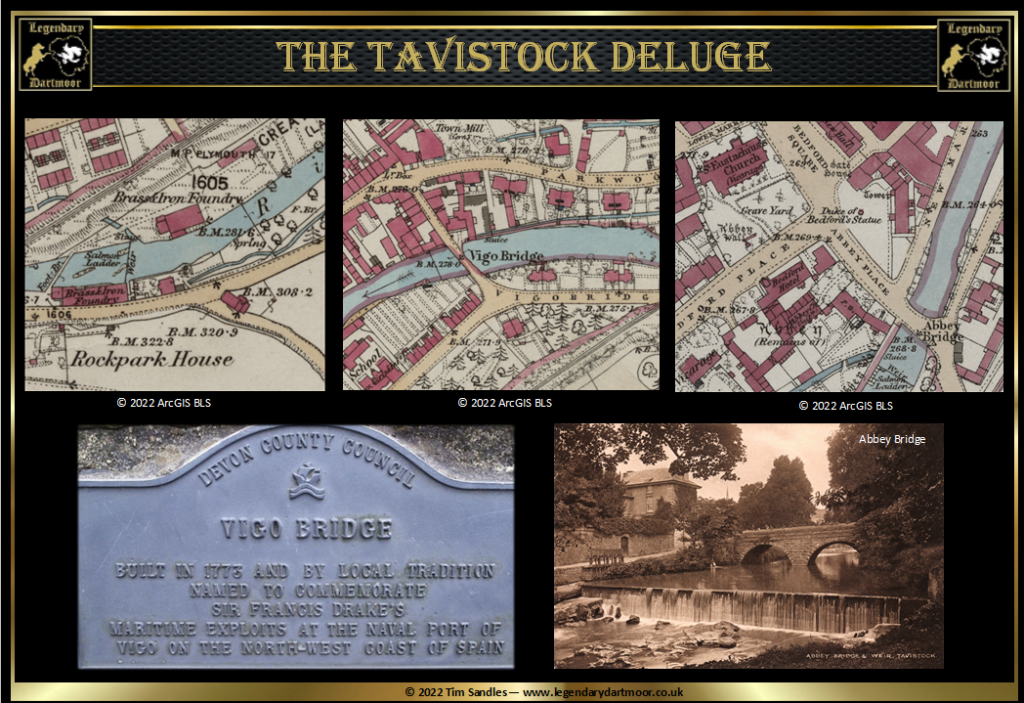
“I am going to bring floodwaters on the earth to destroy all life under the heavens, every creature that has the breath of life in it. Everything on earth will perish.” – Genesis 6:17
On the 17th of July 1890 I would have imagined that that the above biblical prophecy came into the minds of many people living near the river Tavy, especially those in the Tavistock area. At 5 o’clock that morning a fearful thunderstorm broke out over Dartmoor accompanied by tremendous downpour of rain. The first portent of disaster for Tavistock came at seven o’clock in the morning when a torrent of water was seen gushing down over Cox Tor some 424 metres above the town. This was normally a signal that the river Tavy would be in spate and the effects would be felt in the town a couple of hours later. What they did not know was that upstream the torrent had already greatly damaged the Wapsworthy Bridge, the Wapsworthy Brook Bridge and the Horndon Clam. The old clam bridge at Mary Tavy along with the one at Peter Tavy which joined Peter Tavy with Mary Tavy were completely destroyed. The nearby Harford Bridge was described by one witness as being simply “shot away.” To the east of the Tavistock the waters rushing down from Cox Tor had also swept away Merrivale Bridge thus making the Tavistock to Princetown road impassable. By eight o’clock it became clear to the Tavistockonians this was an event of magnitudinal proportions and the raging Tavy was heading towards them at great speed. Many of the streets became flooded to a depth of several feet and houses were soon inundated by the waters forcing many people to take refuge with neighbours on higher land. It was reported that by nine o’clock many of the residents belongings were floating in the waters including clothing, furniture and the like. For some this meant utter ruin as many of the poorer people had no insurance cover. Still the flow and heights of the Tavy began to rise and by nine o’clock devastation was everywhere.
The first to feel the full force of the waters was the Tavy Foundry belonging to Messrs. J. and H. Pearce which witnessed exactly how strong the force of the current was. There was a heavy turbine pipe that was fixed across the river and which simply disappeared. Just below this a sturdy wooden footbridge was lifted up and carried away in pieces. The foundry itself became inundated with around four feet of water which also rushed into a nearby stable inside which was still the horse. A dramatic rescue attempt went underway and luckily after an immense struggle the animal was led to safety. All around the foundry unbelievable sights were seen, heavy iron wheels swept away, a massive iron trough weighing around fifteen hundredweight was hurled some distance from its resting place. In the turning shop the workers had to be evacuated because the water levels were perilously high. The greater part of the sawing shed was smashed into matchsticks and ripped away down the river.
At a cottage near to the foundry the flood bashed through the front door and inundated the downstairs rooms, the owner immediately took his wife and children to a safe haven in their garden. At this point the torrent was starting to reach the north-eastern edge of the town much to the consternation of those in its raging path. Vigo Bridge was the first victim having a massive section of its upper wall demolished which allowed water to rush through with great force and make its way into two cottages. So great was the surge that all the occupants took to the safety of the upstairs rooms. One of the lady occupants gave the following account of her ordeal – “Soon after eight o’clock Thursday morning I was sitting in my kitchen about to commence my breakfast when I heard a rush of water coming from the Tavy nearby. I looked out, and thought it would not be much, but something similar to what we had ten years ago. However, for a precaution, I at once took up my carpets and carried them upstairs and placed several things that were on the floor on top of the tables. Within five minutes I heard a tremendous noise as if there was something rolling along some distance off, and it came nearer and nearer, and on looking out of the window I saw the bridge give way, and the water came rushing along as in a great sheet. I closed my front door, which was open at the time, thinking to keep the flood out, but the force of the water unhinged the door and knocked it to the ground. I then rushed upstairs. From the time I heard the noise of the ruching water to the time I went upstairs was only five minutes, during which time seven feet of water had poured into the kitchen. I sleep on the ground floor, as the upstairs room is occupied by another tenant, and every article of furniture I have is spoiled. I have no more than I stand upright in, and my husband and myself are ruined.” Another neighbour described her plight – “The water shot up from a drain at the back of the house to a height of twenty feet. A nice couch which was kept in the kitchen was found this morning turned over, and all of its legs broken off, and a cupboard had floated some considerable distance. I had not saved an article, and a neighbour gave me a dress to put on as the flood had spoiled everything. In the kitchen was a barrel which was nearly full of flour, and I thought I might be able to save it by rolling it away some distance from the water, but the flood soon overtook me, and it was washed away. Every article of furniture in my house is useless and the kitchen is covered with mud three inches deep.” – The Exeter Flying Post, July 19th, 1890.
Immediately some neighbours sought to get these people to safety and this was achieved by placing a stout plank from a wall which was level to the height of the first cottage’s upper floors across into a window. This allowed the people to crawl along the plank and escape their watery prison. Unfortunately the plank was too short to reach the second cottage so a hole was knocked into the dividing wall between the two cottages. Having done so the second family made their way into the first cottage where they too were led to safety by means of the plank. In Vigo road was the wheelwright’s shop which also suffered a similar fate with dog carts, carriages and other such vehicles being dashed about in all directions. Numerous other articles were carried into the road and then washed away downstream. One poor resident had previously erected a large heated green house which along with the plants inside had set him back fifty pounds this like many other such structures was sent floating down the “Suwannee River“.
In the centre of Tavistock is the iconic Abbey Bridge and fish wear and so great was the volume of water charging under the bridge that the huge granite blocks forming the weir were carried away as if they were small pebbles. Having utterly demolished the weir all that remained was a perfectly level and raging river Tavy. Not far from the bridge is the Guildhall Square in which is unsurprisingly the Guildhall this was where the local lock-up was situated. Inside the lock-up sat a villain who had been arrested the previous night for housebreaking and much to his alarm was soon knee-deep in water. He may well of thought that this was the divine wrath of God seeking vengeance for his transgression? However, it was thought best to relieve him of his anguish and he was eventually removed to dryer ground upstairs, the level of the water having reached around six feet. Many of the nearby shops had the majority of their stocks ruined. Mr. Doble, the chemist, lost vast quantities of paint, vinegar, linseed oil, turpentine and other preparations to the value of £50. Mr. W. Carter the grocer had his sugar, lard, cheese and other provisions decimated beyond redemption. The wool stapler, Mr. T. A. Hill, suffered losses of some £50 due to his wool being saturated. Mr. W. Hill, the china dealer, had vast stocks of china plates, cups etc. either shattered to bits or floated away. The Great Western train that was sitting at the station became inundated, so much so the water extinguished the boiler which had to be re-ignited before it could even consider departing.
In such dire situations there are always people willing to risk life and limb in order to give assistance to those in peril. One such example was the following – “During the morning a young woman heard about the flood and made her way into Brook Street. The water in the thoroughfare was then several feet high, and it came to her knowledge that a couple of young children were in a nearby house. She at once plunged into the water and made her way into the house. Not finding the children in the kitchen, which was half full of water, she wended her way upstairs into the bedrooms, where the two little dots were lying in bed slumbering. Fearing the water would rise still higher and reach the bedrooms she brought them down into the kitchen and thence into the street. With her heavy burden the rushing water was too much for the courageous girl, and she was completely off her legs and carried along with the flood, losing hold of one of the children. A large number of men and women were watching the operations of the girl from various places of security, and a couple of men plunged into the water and rescued her and the children, who were in an exhausted condition. The infant that fell from the girl’s shoulders into the water immediately sank, and in doing so received a nasty cut across the forehead, which fortunately the only real injury caused.” – The Exeter Flying Post, July 19th, 1890.
The only fortunate thing to arise from this disaster was that the flash flood never occurred during the night. Should this have been so then in addition to all the damage there was a real possibility that some people would have lost their lives due to them being asleep when the flood came. All around Dartmoor many other rivers poured forth their torrents, it was this storm that the Cowsic river washed away the huge, heavy clapper bridge at Beardown. As noted above, the waters from Cox Tor combined with the river Walkham took out Merrivale bridge. An unlucky mare and foal belonging to the owner of the Merrivale Inn were taken by the strong current, they managed to extricate themselves further down from the inn. The South Teign river damaged two bridges in the Chagford area. At Rushford Mill the hay crop plus several sheep along with some poultry were lost to the floods which was a scene repeated on many moorland farms. The infamous river Dart managed to completely wash away a half ton buttress from the old bridge at Two Bridges.
As St. Swithin’s Day occurred two days previous to ‘The Tavistock Deluge’ in this instance the prophesised 40 days of rain seems to have occurred in 1 day. Perhaps if someone was reading this some forty years ago they may have thought these events of 132 years ago as being unimaginable. But in recent years they are becoming an all too often occurrence in some parts of the county.
 Legendary Dartmoor The many aspects past and present of Dartmoor
Legendary Dartmoor The many aspects past and present of Dartmoor


